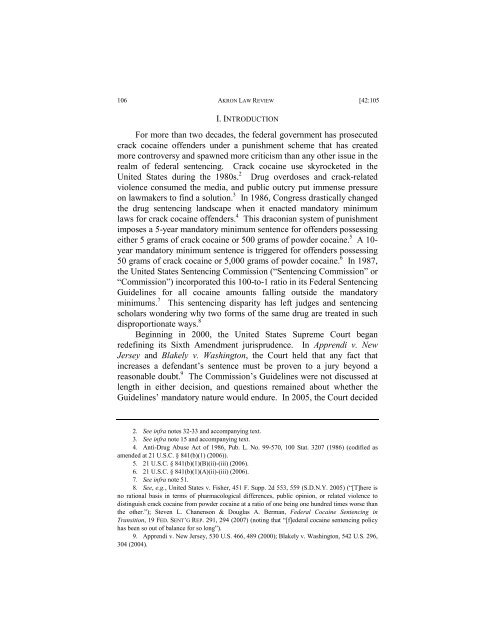Examining Crack Cocaine Sentencing in a Post- Kimbrough World
Examining Crack Cocaine Sentencing in a Post- Kimbrough World
Examining Crack Cocaine Sentencing in a Post- Kimbrough World
You also want an ePaper? Increase the reach of your titles
YUMPU automatically turns print PDFs into web optimized ePapers that Google loves.
08-CASSIDY.DOC<br />
1/29/2009 3:29:23 PM<br />
106 AKRON LAW REVIEW [42:105<br />
I. INTRODUCTION<br />
For more than two decades, the federal government has prosecuted<br />
crack coca<strong>in</strong>e offenders under a punishment scheme that has created<br />
more controversy and spawned more criticism than any other issue <strong>in</strong> the<br />
realm of federal sentenc<strong>in</strong>g. <strong>Crack</strong> coca<strong>in</strong>e use skyrocketed <strong>in</strong> the<br />
United States dur<strong>in</strong>g the 1980s. 2 Drug overdoses and crack-related<br />
violence consumed the media, and public outcry put immense pressure<br />
on lawmakers to f<strong>in</strong>d a solution. 3 In 1986, Congress drastically changed<br />
the drug sentenc<strong>in</strong>g landscape when it enacted mandatory m<strong>in</strong>imum<br />
laws for crack coca<strong>in</strong>e offenders. 4 This draconian system of punishment<br />
imposes a 5-year mandatory m<strong>in</strong>imum sentence for offenders possess<strong>in</strong>g<br />
either 5 grams of crack coca<strong>in</strong>e or 500 grams of powder coca<strong>in</strong>e. 5 A 10-<br />
year mandatory m<strong>in</strong>imum sentence is triggered for offenders possess<strong>in</strong>g<br />
50 grams of crack coca<strong>in</strong>e or 5,000 grams of powder coca<strong>in</strong>e. 6 In 1987,<br />
the United States <strong>Sentenc<strong>in</strong>g</strong> Commission (“<strong>Sentenc<strong>in</strong>g</strong> Commission” or<br />
“Commission”) <strong>in</strong>corporated this 100-to-1 ratio <strong>in</strong> its Federal <strong>Sentenc<strong>in</strong>g</strong><br />
Guidel<strong>in</strong>es for all coca<strong>in</strong>e amounts fall<strong>in</strong>g outside the mandatory<br />
m<strong>in</strong>imums. 7 This sentenc<strong>in</strong>g disparity has left judges and sentenc<strong>in</strong>g<br />
scholars wonder<strong>in</strong>g why two forms of the same drug are treated <strong>in</strong> such<br />
disproportionate ways. 8<br />
Beg<strong>in</strong>n<strong>in</strong>g <strong>in</strong> 2000, the United States Supreme Court began<br />
redef<strong>in</strong><strong>in</strong>g its Sixth Amendment jurisprudence. In Apprendi v. New<br />
Jersey and Blakely v. Wash<strong>in</strong>gton, the Court held that any fact that<br />
<strong>in</strong>creases a defendant’s sentence must be proven to a jury beyond a<br />
reasonable doubt. 9 The Commission’s Guidel<strong>in</strong>es were not discussed at<br />
length <strong>in</strong> either decision, and questions rema<strong>in</strong>ed about whether the<br />
Guidel<strong>in</strong>es’ mandatory nature would endure. In 2005, the Court decided<br />
2. See <strong>in</strong>fra notes 32-33 and accompany<strong>in</strong>g text.<br />
3. See <strong>in</strong>fra note 15 and accompany<strong>in</strong>g text.<br />
4. Anti-Drug Abuse Act of 1986, Pub. L. No. 99-570, 100 Stat. 3207 (1986) (codified as<br />
amended at 21 U.S.C. § 841(b)(1) (2006)).<br />
5. 21 U.S.C. § 841(b)(1)(B)(ii)-(iii) (2006).<br />
6. 21 U.S.C. § 841(b)(1)(A)(ii)-(iii) (2006).<br />
7. See <strong>in</strong>fra note 51.<br />
8. See, e.g., United States v. Fisher, 451 F. Supp. 2d 553, 559 (S.D.N.Y. 2005) (“[T]here is<br />
no rational basis <strong>in</strong> terms of pharmacological differences, public op<strong>in</strong>ion, or related violence to<br />
dist<strong>in</strong>guish crack coca<strong>in</strong>e from powder coca<strong>in</strong>e at a ratio of one be<strong>in</strong>g one hundred times worse than<br />
the other.”); Steven L. Chanenson & Douglas A. Berman, Federal <strong>Coca<strong>in</strong>e</strong> <strong>Sentenc<strong>in</strong>g</strong> <strong>in</strong><br />
Transition, 19 FED. SENT’G REP. 291, 294 (2007) (not<strong>in</strong>g that “[f]ederal coca<strong>in</strong>e sentenc<strong>in</strong>g policy<br />
has been so out of balance for so long”).<br />
9. Apprendi v. New Jersey, 530 U.S. 466, 489 (2000); Blakely v. Wash<strong>in</strong>gton, 542 U.S. 296,<br />
304 (2004).
















